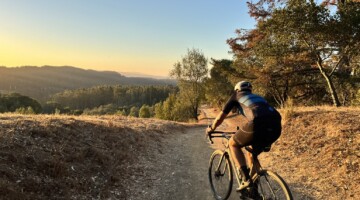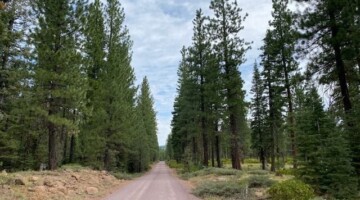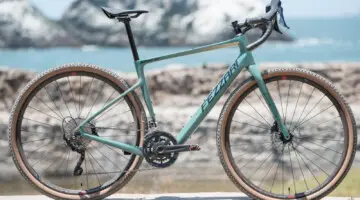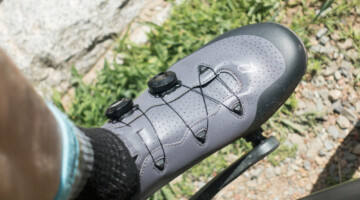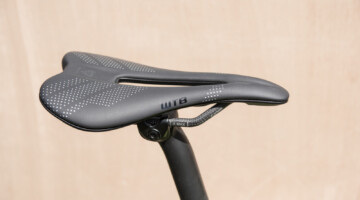Ted King, Josh Berry, Geoff Kabush, Mat Stephens and … Ian Tubbs?
With the growing prestige of the Dirty Kanza 200 and the 2018 field filled with heavy hitters, finishing in the top five in the 2018 Dirty Kanza 200 is an accomplishment of legend. To do so as an amateur is on another level.
At this year’s Dirty Kanza 200, Tubbs, an amateur racer from Washington, finished fourth to join an impressive top five that included the last two DK200 winners. Tubbs rode solo from just after Checkpoint 3 and caught Stephens in the finishing stretch of the 206-mile course to grab fourth place just behind Kabush.
Not surprisingly, Tubbs was excited about his finish. “I was stoked!” he said. “I was really just shooting for top five, and after [Stephens and Kabush] gapped me I thought that’s what I was working to preserve. So to actually get by Mat, who’d won so convincingly last year, I was very happy.”
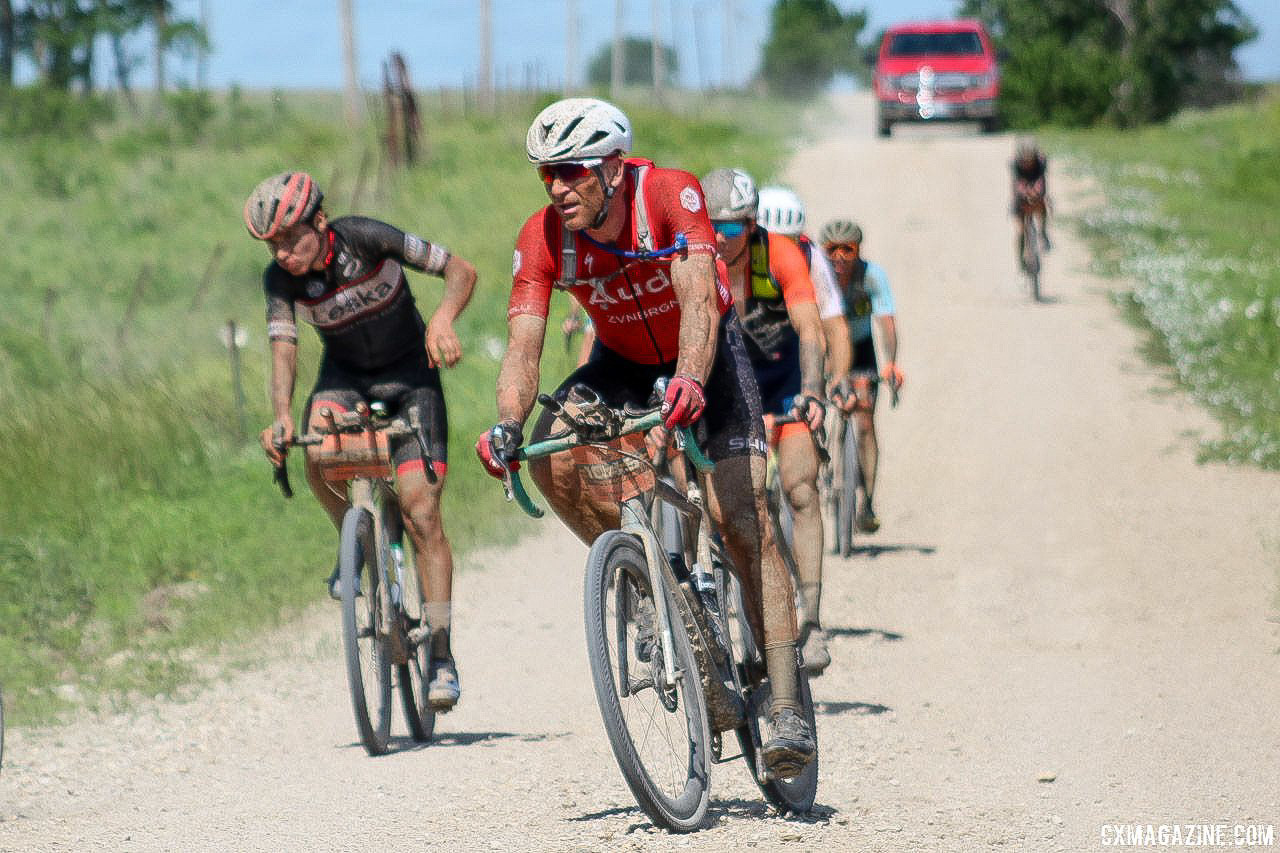
Ian Tubbs finished fourth in the 2018 DK200. 2018 Dirty Kanza 200. © Z. Schuster / Cyclocross Magazine
On paper, Tubbs might be the working person’s hero of the 2018 Dirty Kanza 200, but success at the event is nothing new to him. The Bellevue, Washington resident made the trip to Kansas in 2017 and finished sixth in the race won by Stephens. Tubbs said he was excited about that result as well. “It was my first Dirty Kanza,” he said. “I was definitely surprised. I had high hopes of finishing top 15 or so since a local endurance bad ass I look up to, Brian Ecker, finished 8th in 2015.”
Tubbs one-upped his local hero and returned in 2018 to top his mark from the previous year. So how did Tubbs find himself sprinting for fourth at this year’s Dirty Kanza 200? It started with a mountain bike he got in high school and continued through one 50-mile stretch of pedaling and soul-searching aided by mini-Cokes, aero bars and pure gravel grit.
A Kid from Somewhere
Several of Tubbs’ fellow DK200 podium contenders cut their teeth on the UCI WorldTour and World Cups, but his big races have been local to his Washington home and maybe a Masters Nationals or two.
Tubbs grew up in Jackson, Wyoming, which did not have the biggest bike scene. “I started racing BMX when I was probably 10 or so,” he said. “I didn’t go too far with it though as we were pretty isolated in the small town of Jackson, and I was focused on my childhood passion, alpine ski racing.”
After his first try at BMX, a gift down the road helped him get hooked on cycling. “My next go at bike racing was a couple Norba Mountain bike races after getting a mountain bike as my high school graduation present,” he said. Toward the end of his college years, Tubbs jumped in some mountain bike races and when the dust settled, he was the 1997 Idaho mountain bike state champion in the Sport category.
After college, Tubbs switched to the road where he has raced consistently for the past two decades. He is now a Cat 1 road racer and races in the Elite category in cyclocross—we saw him take third this past season at one of the Seattle area’s MFG Cyclocross series races. Some of Tubbs’ best results include a second-place finish in the 2011 Masters 40-44 Nationals Criterium and top tens in the time trial and road race at the Sea Otter Classic a decade ago. He was, for the record, unclear on how those stacked up against his Idaho state championship on the dirt.
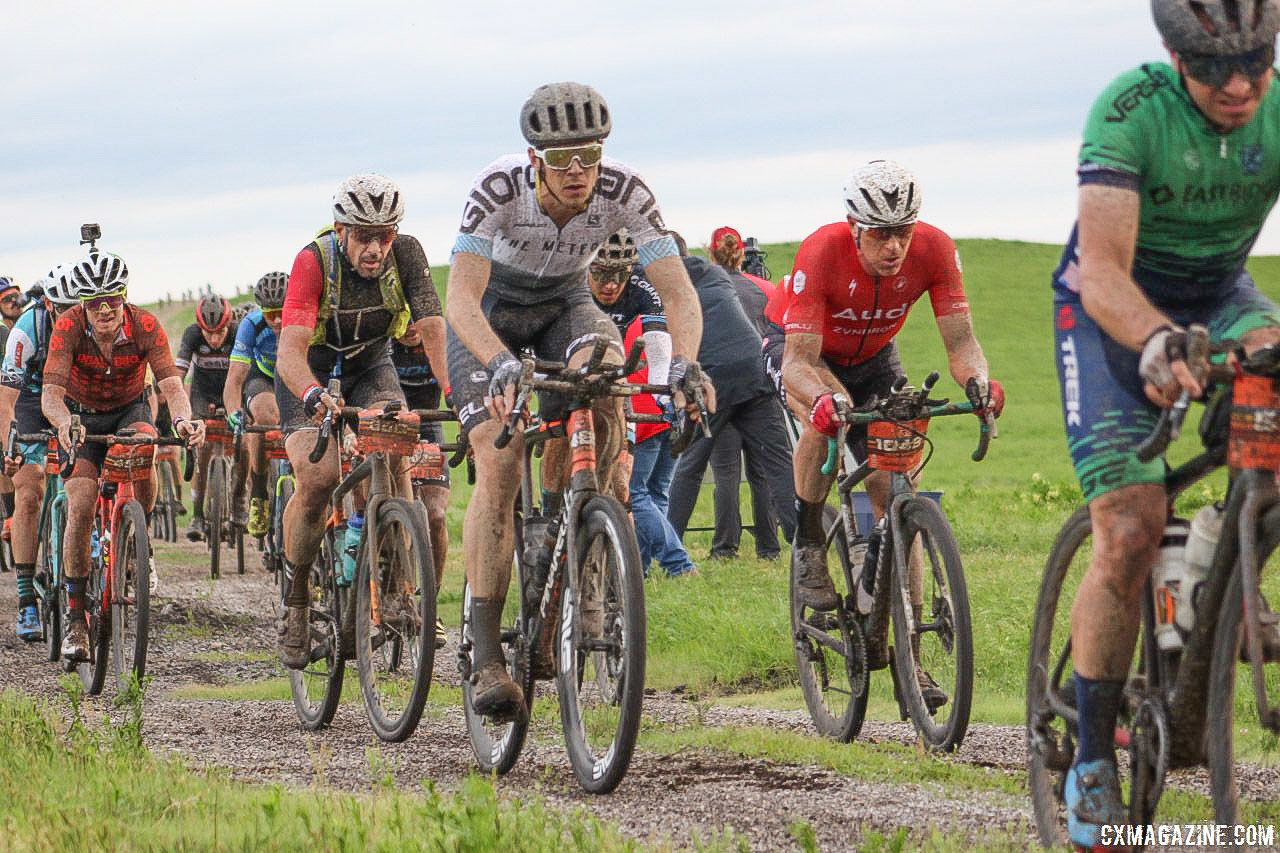
Tubbs (in red Audi kit) was with the leaders early in the race. 2018 Dirty Kanza 200. © Z. Schuster / Cyclocross Magazine
With his background with off-road riding and his Cat 1 road engine, the 47-year-old Tubbs has been a natural fit for gravel racing. In addition to his impressive showing at the 2017 Dirty Kanza, he also tackled Rebecca’s Private Idaho and Gravel Worlds last year. He finished fourth at Gravel Worlds in Nebraska but saw his run of success run into some very DK-like obstacles at Rebecca Rusch’s race.
“I’m headed back to Rebecca’s Private Idaho, where my flat luck ran out last year,” he said. “I was sitting when I should have been hovering on the first descent and bottomed out my rear wheel. After 2 more flats and a lot of chasing, I finished in 28th. I was very happy to have the aero bars on that day.”
With impressive performances at some of the top gravel events in the country, Tubbs said the gravel itch is getting tougher to scratch. “There are quite a few on the bucket list,” he said. “I’d love to do ones I’ve heard about for years like the Crusher in the Tushar and Lost and Found.”
He does have some favorites though. “I’m definitely more suited to the stuff in the Midwest though, being that I’m a bit gravity-impaired at nearly 200 pounds.”
A Second Go at the DK200
Gravel races have their own flow at the front, and for riders coming from other disciplines, figuring out how things work can take a try or two. During his sixth-place finish in 2017, Tubbs adapted quite well and figured out the best strategy for a mass start mêlée like the Dirty Kanza 200.
“The strategy isn’t hard in a race this long,” Tubbs said. “I think last year’s winner Mat Stephens said it best, ‘Stay with the leaders. See who cracks last.’ I’ve also heard it said—maybe by Stephens—that something this long is more of an eating and drinking competition. If you can keep the water, electrolytes and calories going in, you can keep going. So that was my strategy. Eat, drink, pedal. Stay with the leaders as long as possible.”
In an interview after his winning ride, Ted King said it was hard not to note the number of heavy hitters in the DK200 field, to the extent riders were somewhat tentative to attack early in the race. With even King taking note of the names on the starting line, Tubbs said he could not help but do the same, even if he proved he had podium potential in 2017.
“I had set the goal of getting on the overall podium,” Tubbs said about his goal. “However, when I saw who was coming, I was, like last year, thinking a top 15 would be a good finish. It was truly an honor to get to toe the line with the likes of Jens Voigt, Sven Nys, Geoff Kabush, Jordan Rapp, Jamey Driscoll and Ted King. I mean, I’ve spent a lot of time watching these guys on TV, reading about them online and in some cases, even magazines.”
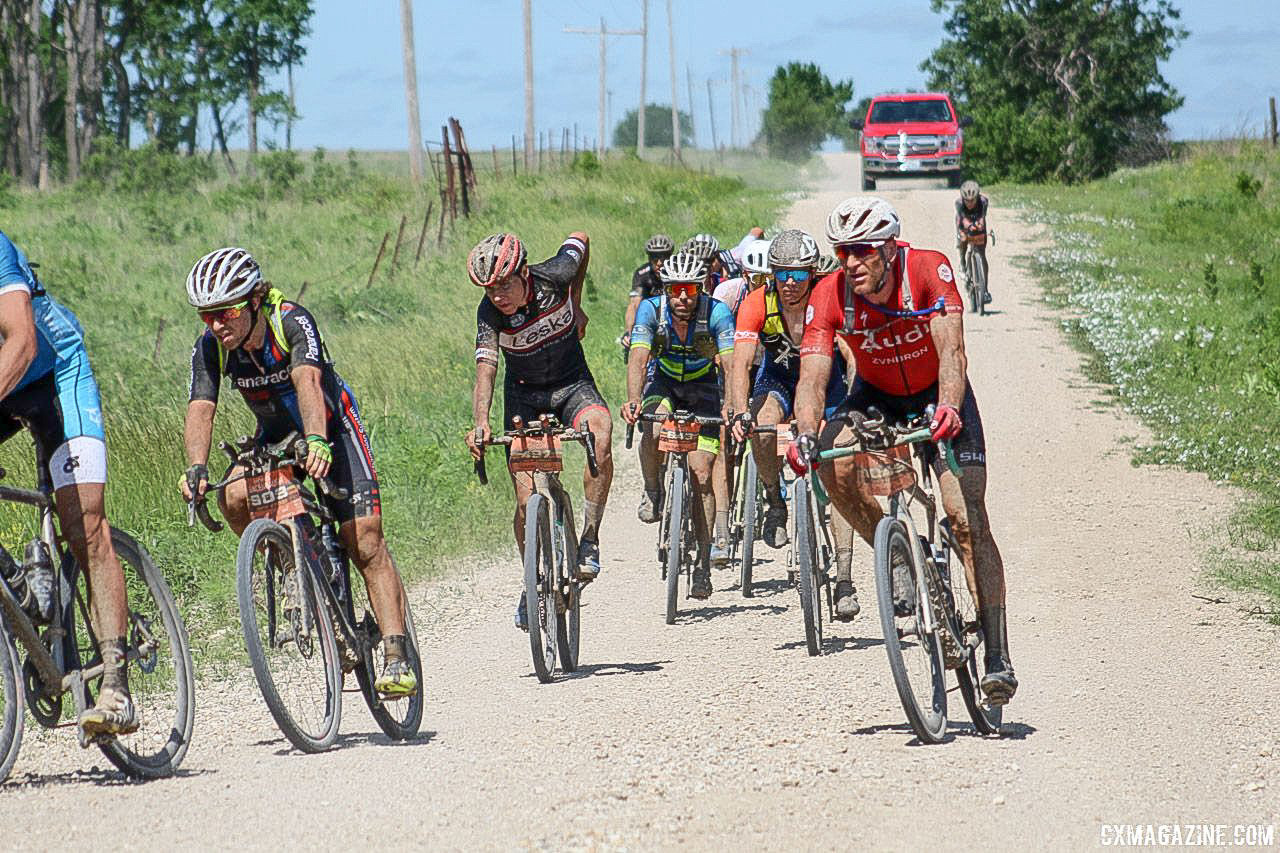
Tubbs’ plan going into this year’s DK200 was to stay with the lead group as long as possible. 2018 Dirty Kanza 200. © Z. Schuster / Cyclocross Magazine
With his strategy of hanging on to the lead group in place, Tubbs was ready for this year’s challenge, even with the early morning inclement weather and 30-minute rain delay to start the day’s racing. Tubbs got in the lead group as it slowly dwindled from 50 to 20 and then to 10 shortly before Checkpoint 2, about 100 miles in.
Despite his impressive first-year success, Tubbs said he did learn some things he wanted to improve upon in 2018. “I learned that quicker transitions through the checkpoints and a more robust tire setup to avoid flatting—or maybe just better luck—would be key to saving as many matches as possible for later in the race,” he said about his lessons from 2017.
Coming out of Checkpoint 2 in Eureka, Tubbs still faced a bit of a gut check. “I was pretty much in the same place as last year after Checkpoint 2, chasing to close about a one-minute gap, despite bringing my own pit crew. That was a bit frustrating because I didn’t think I’d stopped for very long, and certainly not nearly as long as I had last year.”
Tubbs, however, did have a secret weapon for his chase this time around. “At least I had some aero bars this year!” he said.
Perhaps with Stephens’ words about how to succeed at gravel echoing in his ear, Tubbs grabbed his aero bars, dug deep and closed the gap up to a group that included Kabush, Stephens and a few others. A few miles down the road, the chase was down to three. “Once I caught the group I realized, like last year, how small it was compared to how many we rolled into Eureka with,” Tubbs said. “As for what I was thinking, it was, ‘Hey! I’m on the podium!’ Presuming, of course, I could hold off the guys chasing behind.”
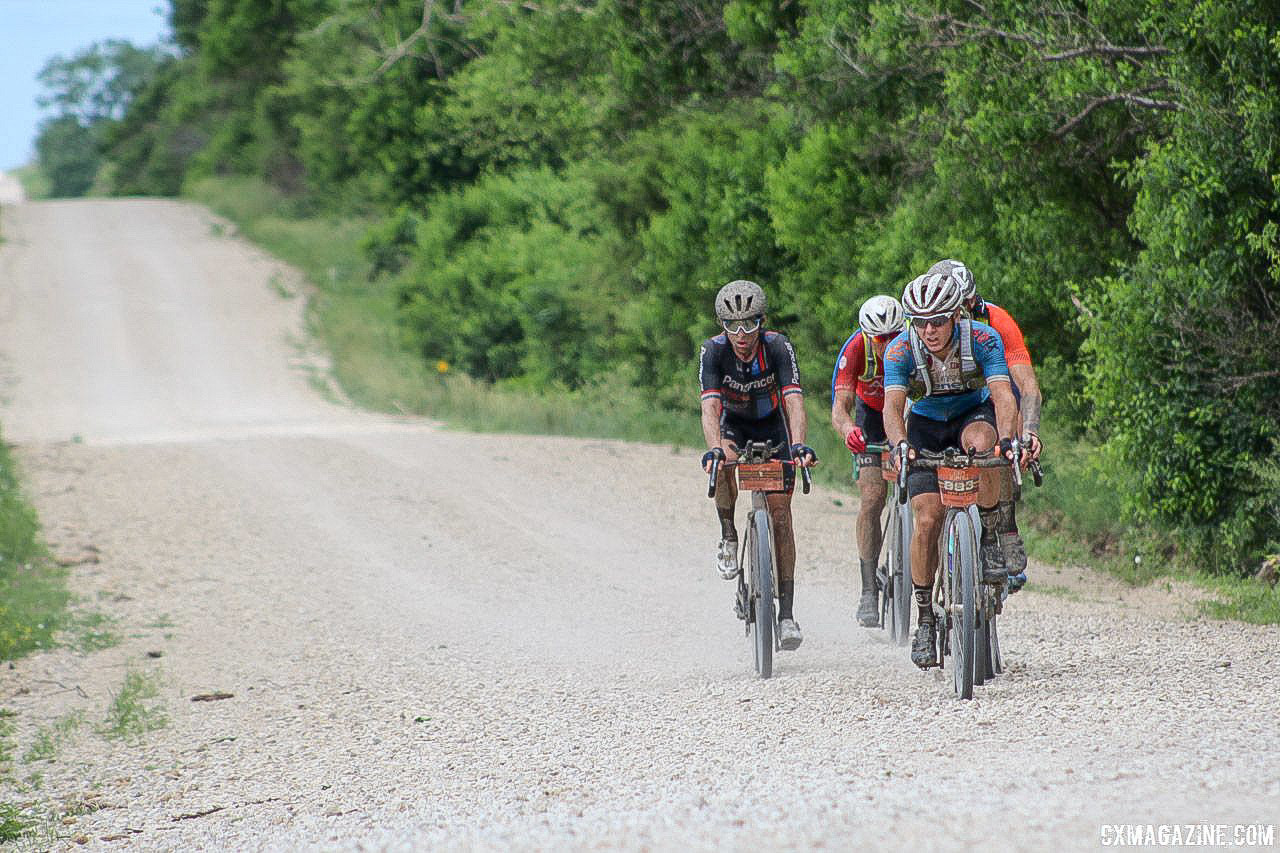
Tubbs (rear) had to bridge up to the chase group coming out of Checkpoint 3. 2018 Dirty Kanza 200. © Z. Schuster / Cyclocross Magazine
Mini-Cokes, TT Mode and One Gutsy Finish
One thing that draws Elites and amateurs together during a gravel race is they all tackle the same course for the same distance. At the 2018 Dirty Kanza 200, they also faced the same 85 miles or so of headwind as they biked north from Eureka back to Emporia. The 206-mile Dirty Kanza course is hard enough on a good day, and with a brutal headwind, everyone was suffering together.
As the riders hit Checkpoint 3, Tubbs was where he wanted to be. Yes, Ted King and Josh Berry were gone up the road, but Tubbs was sitting in the top five with two strong riders to share the work with. However, a group of chasers lingered behind an unknown distance. It’s not like there’s race radio at the DK200 … yet.
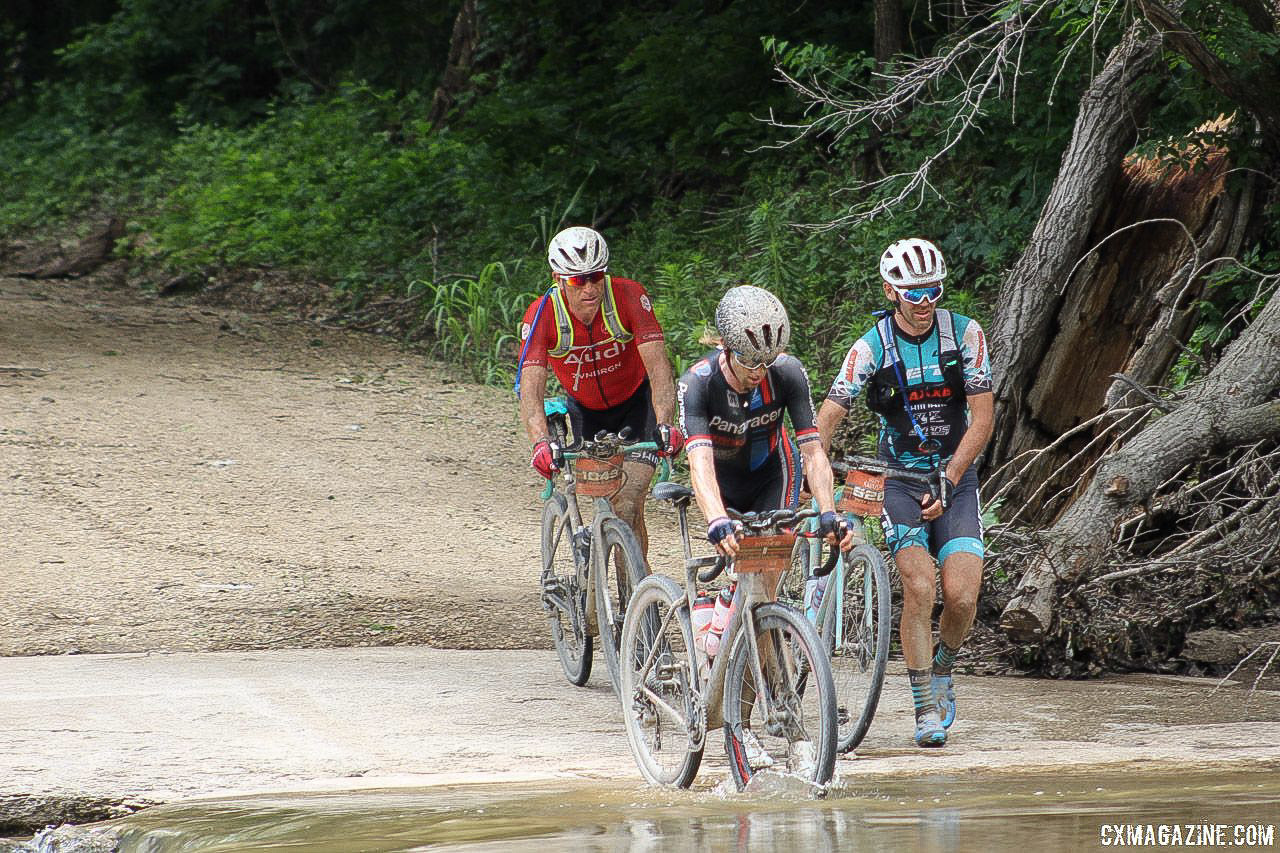
Ian Tubbs was with Mat Stephens and Geoff Kabush at mile 130. 2018 Dirty Kanza 200. © Z. Schuster / Cyclocross Magazine
If Tubbs was in trouble after Checkpoint 2, he faced an even bigger challenge after Checkpoint 3. “Mat waited for Geoff and me [out of Checkpoint 3],” Tubbs said. “It was a few miles later on one of the steeper rollers that they gapped me. I tried chasing back to them for a bit, then I just settled into what I call ‘TT mode’.”
Tubbs had executed his plan perfectly thus far, but we have all seen races where riders close gaps in the waning miles to steal wins and podium spots from those in earlier breakaways. Tubbs knew he still had work to do. “From then on I tried to stay steady with the thought of who might be chasing from behind,” he said about his time in TT mode. “I knew it was likely Jordan Rapp considering his Ironman pedigree, and I will fully admit to sneaking some glances behind on the long straight stretches.”
Perhaps in an effort to prove that he was, in fact, the working person’s hero of the DK200, Tubbs had a more pressing need on his mind. After all, we’ve all been there at *checks notes* mile 160 of a ride and had a craving we needed satisfied, right?
“I’d forgotten to drink my Coke at Checkpoint 3 and was really jonesing for one having seen Geoff polish his off as we left the checkpoint,” Tubbs said about his mid-race craving. “So when I came upon a family farm who were handing out mini-Cokes, I caved and stopped to grab a couple.” He continued, “I think they really helped, especially because I saved the second one for after one of the long three-mile dead straight headwind sections that were just soul-crushing.”
Armed with mini-Cokes and his aero bars for TT mode, Tubbs faced about 50 miles that would test even the toughest Kanza competitor. As he cranked along, he started passing riders on the last stretch of the DK100 and looked for Kabush and Stephens amid the increasing traffic on the dusty gravel roads leading to Emporia. He eventually spotted the duo, and his podium dream was not merely a mirage on the hot, dusty Kansas landscape. “I did notice that I closed back up on Geoff and Mat though,” Tubbs said. “I like to think they noticed too as the gap seemed to stay pretty consistent once I got within sight of them.”
After over 200 miles of gravel, the Dirty Kanza 200 course finishes with an approximately two-mile paved stretch through the east side of Emporia and the campus of Emporia State University. As Stephens and Kabush jockeyed for position before the finishing stretch of their battle for the third podium spot, Tubbs quickly closed the gap. As he approached the I-35 highway crossing, he was only about 20 seconds back. When he came out of the tunnel, the gap was down to 10 seconds.
Tubbs took the call of the finish from there.
“As I was coming out of campus and onto the finish stretch they were still only about six or seven seconds ahead, so I started sprinting as soon as the road straightened out. I got a few pedal strokes in before Geoff jumped Mat. He got a good jump on him, and Mat sat up. I was going full speed at this point so I was able to get by Mat, and I was closing on Geoff pretty quickly. With how small the finish corral is though we had to get off the gas well before the finish line. I’m not saying I would have caught him but it would have been closer!”
In his second go at the Dirty Kanza 200, Tubbs had to “settle” for a fourth-place finish. There is no question Tubbs will be back in 2019, but this time, other riders will likely take keener note of where he is at the front of the race.
The Working Man Hero?
Nearly 1,000 athletes started the Dirty Kanza 200 two Saturdays ago. Nearly all of those riders were amateurs who targeted the Dirty Kanza 200 because of its extreme endurance challenge.
Ian Tubbs was also one of the amateurs who took the line at the DK200. His challenge? It turned out to be battling Geoff Kabush and Mat Stephens for a coveted Dirty Kanza 200 podium spot.
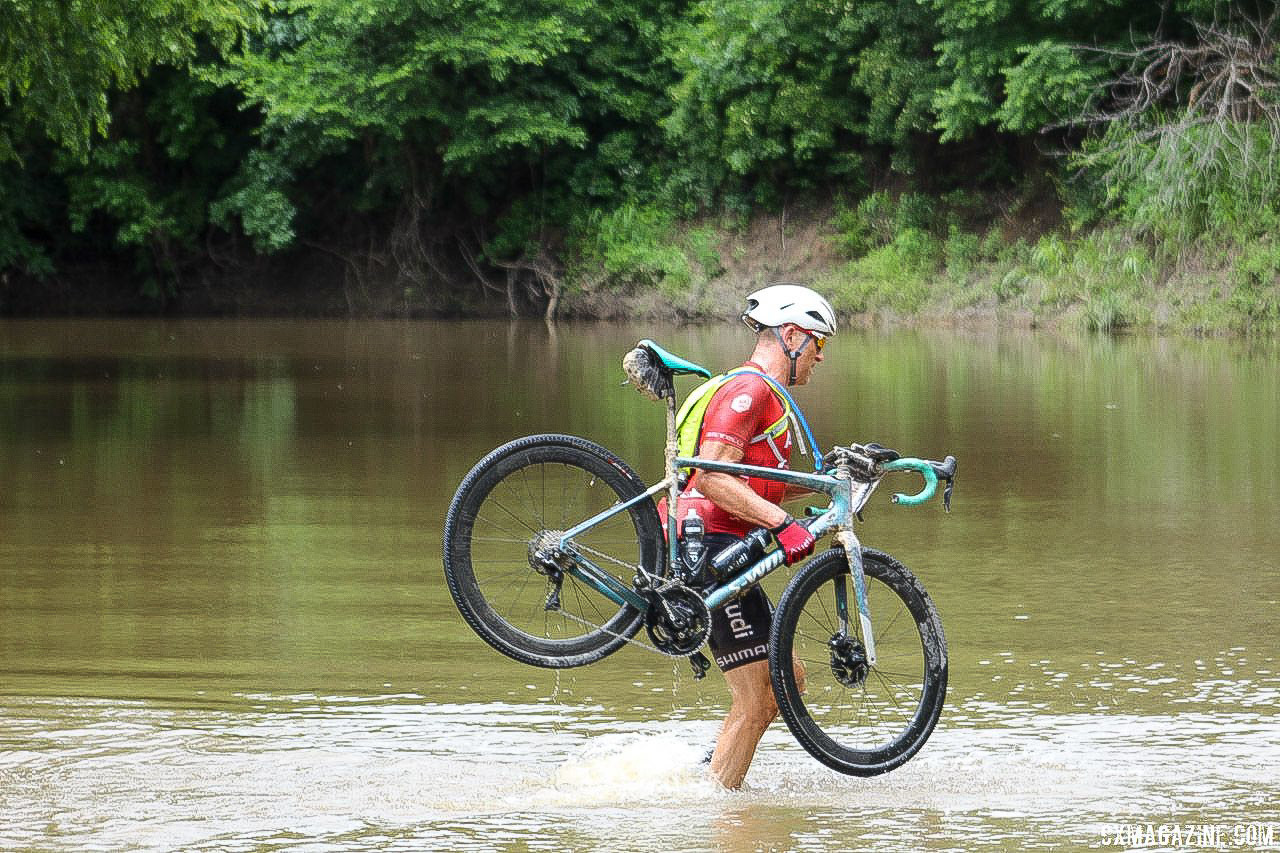
Ian Tubbs crosses Rocky Ford 130 miles into the race. 2018 Dirty Kanza 200. © Z. Schuster / Cyclocross Magazine
So does he feel like a bit of a hero for all the other Masters racers who took on the DK200? “No, absolutely not,” he quickly replied. “There are some truly amazing Masters athletes out there who work way harder than I do and have to balance many more ‘life’ obligations with their training and racing.”
Tubbs also tipped his cap to all his peers who had the guts to take on the Dirty Kanza 200 challenge. “To me, the true Masters heroes out there are the folks who’ve just, or maybe in the last few years, been inspired by this whole gravel riding phenomena and come out and finish at 10 or 11 p.m. or later with huge smiles on their faces. I’m just in awe of that kind of fortitude. I mean I’m out there on course for 11 hours and at that point they’ve still got 5 or more hours to go! So amazing.”
For now, Tubbs is getting ready to enjoy a much-deserved trip to the Dolomites in Italy. When he returns, he will do what amateurs do best, wait until the last minute to sign up for events such as Gravel Worlds. Unlike many of us, however, if he does make the trip to Lincoln, NE in August, he has unfinished podium business against what will likely be yet another loaded gravel field.
As long as Tubbs can get his hands on some mini-Cokes and maybe his aero bars, he will be ready for the challenge.
For more gravel coverage, see our 2018 Dirty Kanza 200 archives.























